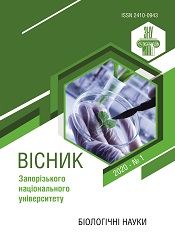Предиктори короткострокової смертності у хворих на гепаторенальний синдром
Анотація
Це дослідження спрямоване на визначення найважливіших предикторів короткострокової смертності пацієнтів із гепаторенальним синдромом за допомогою шкали CLIF-C-ACLF. У дослідженні взяли участь 109 пацієнтів із алкогольним цирозом печінки, ускладненим гепаторенальним синдромом, госпіталізованих до Чернівецького обласного наркологічного диспансеру із січня 2013 року по серпень 2019 року. На момент включення у дослідження пацієнтам було від 29 до 60 років. Середня тривалість алкогольного цирозу печінки (АЦП) становила 3,5±1,54 року; середній анамнез зловживання алкоголем – 8,42±3,53 року; розподіл за статтю становив: 77,9% (n=85) чоловіків та 22,1% (n=24) – жінок. Усі пацієнти отримували стандартну терапію та були розподілені на 2 групи залежно від реакції на лікування: група 1 (n = 57) – респондери, група 2 (n = 52) – нон-респондери. Кількість пацієнтів, які вижили через 1 та 3 місяці, суттєво різнилася в обох групах: 40/57 (70,2%) та 33/57 (57,9%) відповідно у групі респондерів; та 10/52 (19,2%) та 0/52 (0%) відповідно у групі нон-респондерів (p <0,001). Оцінки ймовірності виживання для кожного з членів групи були знайдені за допомогою тесту Каплана-Мейєра. Тип 1 гепаторенального синдрому, відсутність відповіді на лікування протягом перших 24 годин та високий базовий бал за шкалою CLIF-C-ACLF були визначені як предиктори короткострокової смертності. Поліпшення функції нирок під час лікування спостерігалось у більшості пацієнтів групи 1: зниження рівня креатиніну в сироватці крові у респондерів становило від 323,2±91,1 до 121,6±30,0 ммоль/л. Результати дослідження вказують на те, що тип 1 гепаторенального синдрому, відсутність відповіді на лікування протягом перших 24 годин та високий бал CLIF-C-ACLF є найважливішими предикторами виживання у пацієнтів із гепаторенальним синдромом. Моніторинг цих показників дозволяє визначити групу пацієнтів з найгіршим прогнозом та поставити їх на перше місце у списку для трансплантації печінки.
Посилання
(2) European Association for the Study of the Liver. EASL Clinical Practice Guidelines: Management of alcohol-related liver disease. J Hepatol. 2018, 69, 154–181. doi.org/10.1016/
(3) Ginès, P.; Solà, E.; Angeli, P.; Wong, F. et al. Hepatorenal syndrome. Nat. Rev. Dis. Primers. 2018, 4(1), 23. DOI: 10.1038/s41572-018-0022-7.
(4) Kamath, P.S.; Kim, W.R. The model for end-stage liver disease (MELD). Advanced Liver Disease Study Group. Hepatol. 2007, 45(3), 797–805. DOI: 10.1002/hep.21563.
(5) Blatt, N.B.; Cornell, T.T. Acute Kidney Injury Scoring Systems: From Over 30 to 4 (or 1)? Pediatr. Crit. Care Med. 2016, 17(9), 892–894. DOI: 10.1097/PCC.0000000000000894
(6) Zhao, H., Gu, X., Zhao, R., Shi, Y., & Sheng, J. Evaluation of prognostic scoring systems in liver cirrhosis patients with bloodstream infection. Medicine. 2017, 96(50), e8844. DOI: https://doi.org/10.1097/MD.0000000000008844
(7) Arroyo, V.; Moreau, R.; Kamath, P.; Jalan, R. Acute-on-chronic liver failure in cirrhosis. Nat. Rev. Dis. Primers. 2016, 2, 16041. DOI: 10.1038/nrdp.2016.41.
(8) Picon, R. V.; Bertol, F. S.; Tovo, C. V.; de Mattos, Â. Z. Chronic liver failure-consortium acute-onchronic liver failure and acute decompensation scores predict mortality in Brazilian cirrhotic patients. World J. Gastroenterol. 2017, 23(28), 5237–5245. DOI: 10.3748/wjg.v23.i28.5237.
(9) Zaccherini, G., Weiss, E., & Moreau, R. Acute-on-chronic liver failure: Definitions, pathophysiology and principles of treatment. JHEP reports: innov. in hepatol. 2020, 3(1), 100176. doi.org/10.1016/j.jhepr.2020.100176.
(10) Amin, A., & Mookerjee, R. P. Acute-on-chronic liver failure: definition, prognosis and management. Frontline gastroenterol. 2019, 11(6), 458–467. doi.org/10.1136/flgastro-2018-101103.
(11) Maipang, K., Potranun, P., Chainuvati, S., et al. Validation of the prognostic models in acute-onchronic liver failure precipitated by hepatic and extrahepatic insults. PLoS One. 2019, 14(7), e0219516. Published 2019 Jul 10. DOI: 10.1371/journal.pone.0219516.
(12) Cai, Q., Liu, W., Zhu, M., Sheng, J. Microbial Infections as a Trigger for Acute-on-Chronic Liver Failure: A Review. Med Sci Monit. 2019, 25, 4773–4783. Published 2019 Jun 27. DOI: 10.12659/MSM.915637/.
(13) Engelmann, C., Thomsen, K.L., Zakeri, N., et al. Validation of CLIF-C ACLF score to define a threshold for futility of intensive care support for patients with acute-on-chronic liver failure. Crit Care. 2018, 22(1), 254. Published 2018 Oct 10. DOI: 10.1186/s13054-018-2156-0.
(14) Jiang, Q.Q., Han, M.F., Ma, K., et al. Acute kidney injury in acute-on-chronic liver failure is different from in decompensated cirrhosis. World J Gastroenterol. 2018, 24(21), 2300–2310. DOI: 10.3748/wjg.v24.i21.2300.
(15) World Medical Association. World Medical Association Declaration of Helsinki. Ethical principles for medical research involving human subjects. Bulletin of the World Health Organization. 2001, 79( 4) , 373–374. World Health Organization. URL: https://apps.who.int/iris/handle/10665/268312.
(16) European Association for the Study of the Liver. EASL Clinical Practice Guidelines for the management of patients with decompensated cirrhosis. J. Hepatol. 2018, 69(2), 406–460. DOI: 10.1016/j.jhep.2018.03.024.
(17) Rich, J.T.; Neely, J.G.; Paniello, R.C.; Voelker, C.C. et al. A practical guide to understanding Kaplan-Meier curves. Otolaryngol. Head Neck Surg. 2010, 143(3), 331–336. DOI: 10.1016/j.otohns.2010.05.007.
(18) Sersté, T., Lebrec, D., Valla, D., Moreau, R. Incidence and characteristics of type 2 hepatorenal syndrome in patients with cirrhosis and refractory ascites. Acta Gastroenterol Belg. 2008, 71(1), 9–14. PMID: 18396743.
(19) Rodriguez, E., Pereira G., Solà, E. et al. Treatment of type 2 hepatorenal syndrome in patients awaiting transplantation: Effects on kidney function and transplantation outcomes. Liver transplant. 2015, 21, 1347–1354. doi.org/10.1002/lt.24210.
(20) Mindikoglu, A.L.; Pappas, S.C. New Developments in Hepatorenal Syndrome. Clin. Gastroenterol. Hepatol. 2018, 16(2), 162–177. e1. DOI: 10.1016/j.cgh.2017.05.041.
(21) Barreto, R., Fagundes, C., Guevara, M. et al. Type-1 hepatorenal syndrome associated with infections in cirrhosis: natural history, outcome of kidney function, and survival. Hepatol. 2014, 59(4), 1505–13. DOI: 10.1002/hep.26687.
(22) Perdigoto, D., Figueiredo, P., Tomé L. The role of the CLIF-C and the MELD in prognosis of cirrhosis with and without Acute-on-Chronic Liver Failure. Annals of Hepatol. 2016, 18 (1), 48–57. DOI: 10.5604/01.3001.0012.7862.
(23) Srivastava, S.; Shalimar, T.; Vishnubhatla, S.; Prakash, S. et al. Randomized controlled trial comparing the efficacy of terlipressin and albumin with a combination of concurrent dopamine, furosemide, and albumin in hepatorenal syndrome. J. Clin. Exp. Hepatol. 2015, 5(4), 276–85. DOI: 10.1016/j.jceh.2015.08.003.

 ISSN
ISSN 




